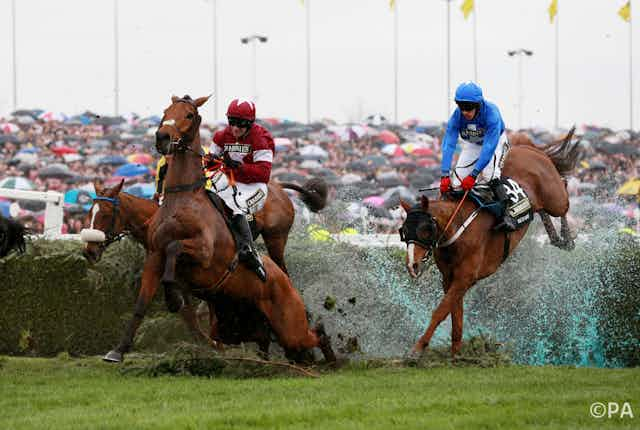The Grand National is so much more than a horse race. Taking place at Aintree, near Liverpool, its 40 runners are watched by more than 600m people in 140 countries, with a betting turnover many times larger than the next biggest betting race in the UK, the Cheltenham Gold Cup. It is also an especially rich pay day for the bookmakers as the odds on offer are particularly heavily skewed in their favour.
When a horse named Lottery won the first running of the race in 1839, the Grand National was a steeplechase in which all runners carried the same weight. It was to be four years before the rules were changed to establish a handicap system that makes the race today so unpredictable.

All horses are allocated different weights: those with the weakest form carry the least weight on their backs, and vice-versa. This means that the once-a-year bettor can stake a couple of pounds on a 100-to-1 shot and believe they have at least a chance of winning, as well as enjoying the thrills and spills of watching the race. It has been estimated that two-thirds of the adult population in the UK bet on the race, contributing to a turnover for bookmakers of more than £150m.
Part of the National’s appeal is its history of dramatic upsets. Most famous is the 1967 pileup fiasco in which a riderless horse aptly named Popham Down veered across the leaders at the 23rd fence, causing mayhem as horses careered into each other. The trailing longshot Foinavon was able to avoid the melee and romp home to the mixed cheers and tears of the crowd. On the Tote, the pool system of betting which operates alongside the bookmakers, backers of Foinavon were paid out a record 444-to-1. In 1984, the fence was renamed the Foinavon fence, adding to the legend of the course.
Events like these, which are part of the rich fabric of the race’s chequered history, combined with the huge field size, the imposing fences and the long double circuit, are part of what makes the race so popular to watch – and bet on.
Special stories

Each year always seems to produce its own special story. Perhaps the most stirring was the 1981 race, which was turned into the movie Champions. Jockey Bob Champion and horse Aldaniti both made an unlikely return from serious illness and injury and stormed up the long final stretch to win by four lengths.
Not all Grand National stories end as gloriously, however. Perhaps the most famous case is the 1956 race. In that year, Queen Elizabeth the Queen Mother’s horse, Devon Loch, was well clear on the final stretch when he suddenly jumped into the air in front of the royal box and fell on his stomach. “That’s racing!” was the Queen Mother’s stoic response. To this day, it is unclear what happened, but “to do a Devon Loch” has entered the lexicon of sports journalism as a metaphor for a sudden late collapse when victory seems assured. The jockey that day, Dick Francis, went on to become a famous writer of horse racing thrillers and Devon Loch made a complete recovery.
Not all horses are so lucky, and the number of horses that have fallen at the tall National fences and been put down as a result has long coloured some of the public perception of the race. Organised opposition to it was probably most vividly reflected in the 1993 “race that never was”. After animal rights protesters invaded the course and delayed the start, confusion between the starter, officials and riders led to the majority of jockeys heading off, oblivious to the race being declared a false start. Flag-waving officials were ignored by many of the riders who thought them to be protesters. The “winner”, Esha Ness, is not included in the official roll-call of past champions, but has gone down as another name in the race’s folklore.

No account of the Grand National can ever be complete, however, without mention of the greatest champion of them all: Red Rum. Starting with a late comeback victory from 30 lengths down in the 1973 race, Red Rum (which spells “murder” backwards) went on to win again in 1974 and 1977. In the intervening years he came second. Before “Rummy”, as he was affectionately known, rose to prominence the future of the National was in doubt because of fears that the Aintree racecourse would be sold for redevelopment. After Red Rum entranced the nation, that was never the case again.
What has ultimately secured the National, however, is its ability to change with the times. The once life-threatening fences, like the iconic Becher’s Brook, have been gradually made much safer, so that the once gladiatorial appeal of the race has evolved into a love of the race as a national – and international – event.

